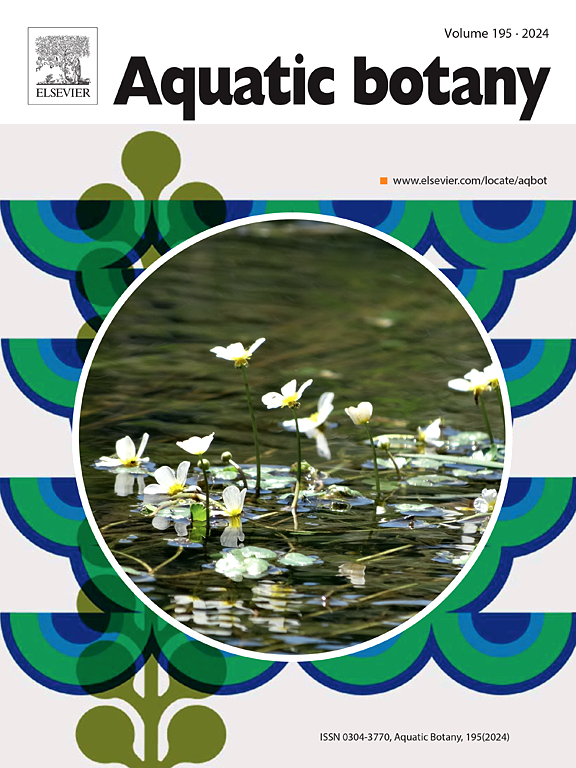Littorella uniflora (L.) Asch.叶片和根中碳和氮稳定同位素组成的变化与水的 pH 值和养分供应的关系
IF 2.6
4区 生物学
Q2 MARINE & FRESHWATER BIOLOGY
引用次数: 0
摘要
在一项植物实验中,通过分析稳定的碳和氮同位素(δ13C 和 δ15N),研究了 pH 值变化和富营养化对软水湖泊中异叶植物的影响,特别是 Littorella uniflora (L.) Asch.这项研究于 2020 年 10 月下旬进行,对波兰格但斯克附近扎维亚德湖的 200 个标本进行了为期 75 天的检测。研究测试了三个 pH 值水平(∼4.5、∼7.0 和∼8.5)和详细的 12 级营养梯度(氮:0-10 毫克/升;磷:0-0.3 毫克/升)。分析的重点是叶片和根部的同位素组成,结果表明,酸性条件下的δ13C 值较高(叶片:-22.67 ‰;根部:-23.23 ‰),这表明光合作用偏好轻碳形式,并大量利用有限的二氧化碳来源。中性 pH 值变体的 δ13C 值最低(叶:-25.53 ‰;根:-25.47 ‰),表明其条件较差。δ15N值在不同的pH值水平下波动很小,与中性条件相比,酸性和碱性环境中的δ15N值略有变化。随着养分的增加,在所有 pH 值水平上观察到的δ13C 值下降,同时δ15N 值上升,这表明同位素组成与环境因素之间存在复杂的相互作用。我们的研究结果表明,L. uniflora 对不同的 pH 值有不同的同位素反应,在酸性条件下,δ13C 值较高,这可能表明其通过专门的碳同化策略提高了对二氧化碳的吸收。这凸显了该物种对环境压力的适应机制,表明水生植被的同位素组成可以作为湖泊生态系统变化的敏感指标。本文章由计算机程序翻译,如有差异,请以英文原文为准。
Variation of carbon and nitrogen stable isotope composition in leaves and roots of Littorella uniflora (L.) Asch. in relation to water pH and nutrient availability
In a phytotron experiment, the effects of pH variation and eutrophication on isoetids plants from soft-water lakes specifically the submerged form of Littorella uniflora (L.) Asch. was investigated by analyzing stable carbon and nitrogen isotopes (δ13C and δ15N). Conducted in late October 2020, 200 specimens from Lake Zawiad, near Gdansk, Poland, were examined over 75 days. The study tested three pH levels (∼4.5, ∼7.0, and ∼8.5) and a detailed 12-step nutrient gradient (nitrogen: 0–10 mg/l; phosphorus: 0–0.3 mg/l). The analysis focused on isotopic composition in leaves and roots, revealing that acidic conditions favored higher δ13C values (leaves: −22.67 ‰; roots: −23.23 ‰), suggesting a preference for lighter carbon forms in photosynthesis and intensive use of limited sources of CO2. The neutral pH variant showed the lowest δ13C values (leaves: −25.53 ‰; roots: −25.47 ‰), indicating less optimal conditions. δ15N values exhibited minimal fluctuation across pH levels, with slight variations in acidic and alkaline environments compared to neutral conditions. An observed decrease in δ13C across all pH levels with increased nutrients, alongside a rise in δ15N values, indicates a complex interaction between isotopic composition and environmental factors. Our findings suggest that L. uniflora shows a distinct isotopic response to varying pH levels, with higher δ13C values under acidic conditions potentially indicating enhanced CO2 uptake through a specialized carbon assimilation strategy. This highlights the species' adaptive mechanisms to environmental stressors, suggesting that the isotopic composition of aquatic vegetation can serve as a sensitive indicator of changes in lake ecosystems.
求助全文
通过发布文献求助,成功后即可免费获取论文全文。
去求助
来源期刊

Aquatic Botany
生物-海洋与淡水生物学
CiteScore
3.80
自引率
5.60%
发文量
70
审稿时长
6 months
期刊介绍:
Aquatic Botany offers a platform for papers relevant to a broad international readership on fundamental and applied aspects of marine and freshwater macroscopic plants in a context of ecology or environmental biology. This includes molecular, biochemical and physiological aspects of macroscopic aquatic plants as well as the classification, structure, function, dynamics and ecological interactions in plant-dominated aquatic communities and ecosystems. It is an outlet for papers dealing with research on the consequences of disturbance and stressors (e.g. environmental fluctuations and climate change, pollution, grazing and pathogens), use and management of aquatic plants (plant production and decomposition, commercial harvest, plant control) and the conservation of aquatic plant communities (breeding, transplantation and restoration). Specialized publications on certain rare taxa or papers on aquatic macroscopic plants from under-represented regions in the world can also find their place, subject to editor evaluation. Studies on fungi or microalgae will remain outside the scope of Aquatic Botany.
 求助内容:
求助内容: 应助结果提醒方式:
应助结果提醒方式:


